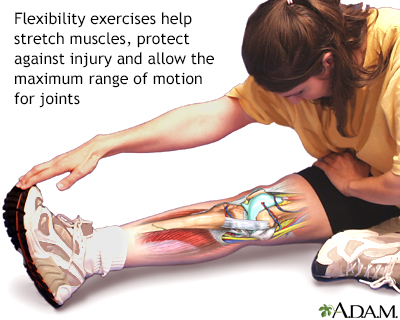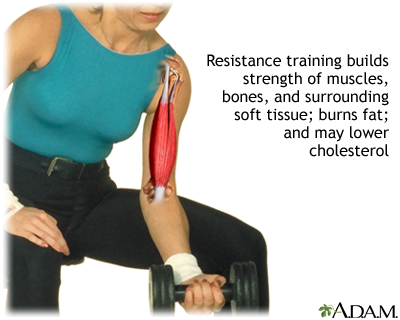Return to Index
Step 1: Welcome
Step 2: The Benefits Of Exercise
Step 3: Before You Begin
Step 4: How Much Exercise is Enough?
Step 5: Types Of Exercise
Step 6: Why Use Weights?
Step 7: Warm Up, Cool Down, And Stretch
Step 8: Stay Safe
Step 9: Just Getting Out the Door
Step 10: Overcoming Roadblocks
Key Points
MedTest
Glossary
*Close Menu*
Return to Index
Step 1: Welcome
Step 2: The Benefits Of Exercise
Step 3: Before You Begin
Step 4: How Much Exercise is Enough?
Step 5: Types Of Exercise
Step 6: Why Use Weights?
Step 7: Warm Up, Cool Down, And Stretch
Step 8: Stay Safe
Step 9: Just Getting Out the Door
Step 10: Overcoming Roadblocks
Key Points
MedTest
Glossary
*Close Menu*
| Step 5: Types of exercise |
There are three major types of exercise, and each contributes something different to overall fitness. In general, a balanced program would include all three types.
- Cardiovascular training -- also called aerobic training, this type of exercise builds endurance by keeping the heart pumping for an extended period of time. It helps increase the pumping ability of your heart, relaxes blood vessels, improves cholesterol, strengthens bones, and helps you lose weight. Once you have worked up to it, shoot for 3 - 4 hours in your target zone per week, spread out through the week. Some aerobic exercise is considered "low to moderate impact," which most people in reasonably good health can perform -- examples include brisk walking, swimming, and climbing stairs. These can all be very beneficial, so it is not necessary to work up to "high-impact" aerobic activities like running, dance exercise, and tennis.

- Flexibility training -- these exercises help your muscles stretch farther in a given direction. Flexibility training helps prevent cramps, stiffness, and injuries, and can give you a wider range of motion. These exercises also emphasize proper breathing, balance, and alignment. Some forms of flexibility training, such as yoga, pilates, and tai chi, include meditation and breathing techniques that can reduce stress.

- Weight training -- also called strength or resistance training, these exercises build up your muscles and help maintain bone density. Strength training involves performing repetitions ("reps") that move specific muscles in the same pattern repeatedly against a resisting force. Aim for 30 - 45 minutes of strength training 2 - 3 times per week. Consider finding a trained professional (like a physical therapist or a personal trainer) who can teach you how to use weights safely and effectively.

 |
Review Date:
6/28/2011
Reviewed By: Jeffrey Heit, MD, Internist with special emphasis on preventive health, fitness and nutrition, Philadelphia VA Medical Center, Philadelphia, PA. Review provided by VeriMed Healthcare Network. Also reviewed by David Zieve, MD, MHA, Medical Director, A.D.A.M., Inc.
Reviewed By: Jeffrey Heit, MD, Internist with special emphasis on preventive health, fitness and nutrition, Philadelphia VA Medical Center, Philadelphia, PA. Review provided by VeriMed Healthcare Network. Also reviewed by David Zieve, MD, MHA, Medical Director, A.D.A.M., Inc.
The information provided herein should not be used during any medical emergency or for the diagnosis or treatment of any medical condition. A licensed medical professional should be consulted for diagnosis and treatment of any and all medical conditions. Links to other sites are provided for information only -- they do not constitute endorsements of those other sites. No warranty of any kind, either expressed or implied, is made as to the accuracy, reliability, timeliness, or correctness of any translations made by a third-party service of the information provided herein into any other language. © 1997-
A.D.A.M., a business unit of Ebix, Inc. Any duplication or distribution of the information contained herein is strictly prohibited.
A.D.A.M. content is best viewed in IE9 or above, Firefox and Google Chrome browser.
